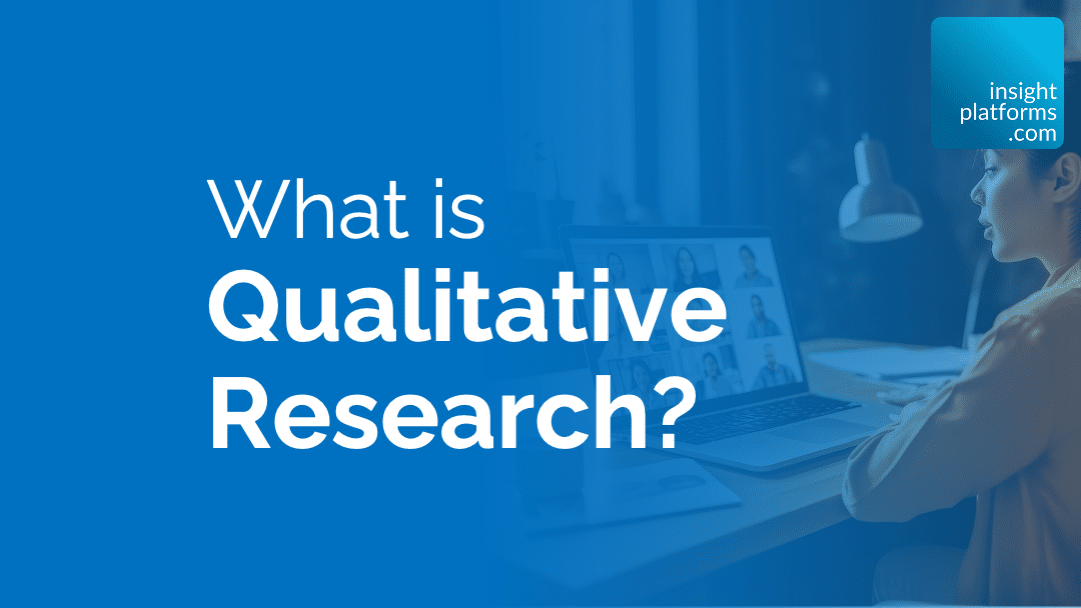
What is Qualitative Research?
By Insight Platforms
- article
- explainer
- Qualitative Research
- Remote Qualitative Research
- Online Qualitative
- Mobile Qualitative
- Ethnography
- Mobile Ethnography
- Group Discussions/Focus Groups
- Online Focus Groups and Forums
- Online Communities
- Video Diary Studies
- Diary Studies
Too often, when people think of qualitative in comparison to quantitative research, they think it’s all about interviewing people and that data is subjective and biased. When in reality, qualitative research is about as close as you can get to data representative of human behavior. Numbers are stagnant. Humans are far from that.
In our Essentials of Qualitative Research course, we’re defining qualitative research as “using conversation or observation to understand people’s needs, attitudes, and behaviors independently of how many people do it.”
Qualitative Research Objectives
The goal of qualitative research is to discover the thoughts and experiences behind data. That means, in any research involving human experience, you’ll find qualitative. For example, researchers may seek qualitative insights to:
- Evaluate innovative products before launch
- Learn how customers speak and what language they use
- Identify consumer types and how they express themselves
- Evaluate advertising risk before airing
- Help understand quantitative results
The main goal of qual research is to dig deep into people’s experiences by understanding why and how they think, feel, or act the way they do. While you can always guess and infer what the sentiments are behind numerical insights, this leaves gaps for misunderstanding, confirmation bias, data misrepresentation, or worse. It is nearly impossible to predict human behavior accurately, so rather than making the mistake of misinterpreting data and making assumptions, it is recommended to do the extra work (those extra qual interviews) to ensure you’re digesting the data and curating the reports get it as right as possible.
Most Common Qualitative Research Methodologies
Moving on to the actual practice of qualitative research–how is it done? How do researchers take insights on human behavior, sentiment, and perception and turn them into actionable data?
Qualitative research is usually done in small groups or 1-on-1 interviews, where an experienced facilitator / moderator opens a discussion with participants who are chosen based on certain demographics, identity or personality traits, and consumption habits (screened prior).
Since 2020, a lot more research has been conducted online, which opens up the data and participant pool to potentially global or non-local audiences and offers the advantage of new integrated online tools. This is favorable from a diversity and inclusion perspective since it gives researchers access to a wider range of respondent profiles (eliminating geographical barriers, including underrepresented minorities as well as participants with disabilities). However, it also has its downsides as respondents with poor connectivity or those who are not tech-savvy enough may be underrepresented.
Focus groups (online or in-person)
Focus groups are one of the most common methodologies for qualitative research, and they often include group discussions between 4-8 individuals. These discussions can last up to 2 hours and can be hosted online or in person. The facilitator follows a previously designed discussion guide that aims to shed light on the business questions the research is being conducted to answer.
However, working in an open discussion with multiple people can have its own difficulties. Researchers must pay careful consideration to group dynamics, noticing if certain participants are uncomfortable or unable to share their point of view or perspective uninterrupted by other group members’ thoughts.
Some focus groups may also be conducted in a non-traditional setting: through video, in a live chat format, moderated by chatbots, as discussion forums (moderated or unmoderated), and as online closed communities (moderated or unmoderated).
In-Depth Interviews (online or in-person)
In-depth interviews (also known as IDIs) consist of 1-on-1 interviews, where a moderator meets with participants individually, online or in-person, to gain insights into their experiences without the additional pressure of other discussion participants. IDIs can also be conducted with 2 respondents (called ‘dyads’) or 3 respondents (‘triads’). For example, dyads can be used when moderators need input from minors who must have a legal guardian present. Any IDI with more than 3 respondents is considered a focus group.
These individual interviews typically range from 45 minutes to 90 minutes and are typically used for conversations and lines of questioning (again, based on a carefully curated discussion guide to steer the conversation) relating to more sensitive or personal topics. They focus on gathering detailed insights into more emotional experiences or opinions and are ideal for professional and expert assessments.
Ethnographies
Ethnographies are another form of small group conversations and can consist of either 1-on-1 interviews or groups of 2 to 3 participants. These discussions go for up to 2 hours and can be conducted online to review digital behavior or content.
What sets ethnographies apart from other qualitative methods? The interviewer immerses themselves in the participant’s world and accompanies them with their routine daily activities and places. Why?
The aim of ethnographic research is to observe subjects in their natural processes to evaluate consumption decisions, usage behavior, and other consumer behaviors. A few examples of this would be observing employees in an office or medical professionals in a hospital or following someone on a shopping trip (called a shop-along).
In recent years, some ethnographies have taken up a digital form through live video streaming or through asynchronous video feeds where respondents record their experience / journey and researchers analyze that later.
Observation Research
Observation qualitative research does just that – moderators observe participants without direct interaction. The goal is for researchers to have an opportunity to assess and watch participant behavior, without the support or bias that may trickle in through individual or small group interviews.
In an observational qualitative practice, researchers may study live interaction or video recordings of a situation. Recently, online journals and diaries have also gained popularity among qualitative researchers. Participants are assigned a workspace and periodical tasks and are asked for their input in text/audio/video form.
The Role of the Qualitative Moderator
Now that we’ve broken down different methods of qualitative research – there’s a key component we have not yet talked about: The role of discussion moderators (also referred to as interviewers or discussion facilitators).
Obviously, the moderator asks the participants questions, but they’re also responsible for guiding and organizing the research conversations. They keep track of how much time is spent on certain discussion points and observe the conversation dynamics occurring between participants. They are also responsible for creating a safe and comfortable environment for participants to share freely. Moderators are also tasked to look for signals and prompt respondents to learn more about newly discovered insights (called probing).
Understanding how to lead other humans in conversations, without bias, that lead to applicable insights is no easy feat. Here are a few important qualities discussion moderators typically need to facilitate accurate qualitative research:
- Energy to engage people
- Let the conversation flow naturally
- Ensure everyone expresses their opinion
- Build empathy, trust, and rapport in the first few minutes–make people comfortable to open up
- Must be impartial and nonjudgmental
- watch out for tone and body language
- Stay alert to cues that lead to new possibilities to explore
- Know the subject well to be able to judge the importance of exploring something further
- Be curious – use open (non-leading) questions
Finding the Right Qualitative Respondents
We already mentioned how qualitative research participants are chosen based on reasoning rather than on random.
Qualitative research participants are screened and selected specifically based on demographic data, certain traits, routines, or behaviors. They may or may not have any relationship with the studied brand or topic in question, depending on the business question to answer. Research participants can be recruited from a number of spaces, including third-party panels, social media ads, personal networks, word of mouth, CRM, research databases, or ‘snowballing’, which is asking previous study participants to participate again.
Respondents are typically compensated in monetary or non-monetary forms. Most often, it’s a cash incentive (sometimes gift cards), and, in some cases, it’s pledged donations or a gift from the brand – the product that respondents are asked their opinions / perceptions on.
Most Common Qualitative Research Outputs
After fieldwork is completed and data analysis starts, where researchers dive deep into responses and the information collected, it’s key to make the most out of these qualitative insights.
Storytelling is crucial. The role of qual research is to learn about a broad topic or ‘the Big Picture’ through the experiences and perspectives of a few individuals. The golden nuggets lie in spotting nuances, caveats, and repeating patterns. These themes that come up in the initial discussions may be worth exploring further in the future in some follow-up pieces of research (qualitative or quantitative).
Research findings are typically presented in the form of a report. These may be full (or comprehensive) reports that are detailed reports diving deep into the topic and the findings from all markets, often between 60-150 slides. Alternatively (or as a complement), research findings are collated into topline reports, a brief summary of the research results across markets (between 20-40 slides). In both cases, some key deliverables in reports are:
- Persona Segmentation
- Verbatims or transcripts (text, audio, or video)
- Customer journey maps or buyer journeys
- Wireframes / blueprints
- Video reports / stories
- Infographics
- Jobs-to-be-done (JBTD)
Qualitative research insights can provide an overwhelming amount of data, which is why it is crucial to focus on clearly defined business objectives and prioritize key questions in order to extract actionable insights.


